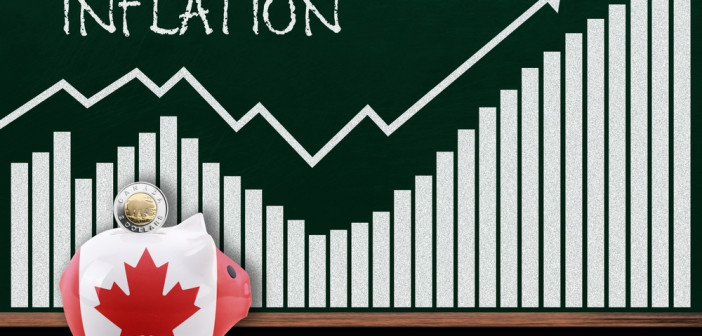While many Canadians are ready to get off the roller-coaster that is our economy, it seems like the ride may still have some twists and turns left.
Interest rates rose again in July 2023, and have stayed steady ever since, after a series of hikes that began at the end of 2022. Mortgage rates, in turn, remain high, though already we are seeing some softening. The housing market is also seeing some positive activity after a quiet 2023.
Here’s a round-up of the latest when it comes to pricing—from food prices to gas prices—along with advice on how you can prepare for what’s to come.
Bank of Canada Pauses Policy Rate Again
The Bank of Canada’s (BoC) string of interest rate hikes seemed to have helped tame inflation without hurting the economy.
In its most recent rate announcement on March 6, 2024, the BoC again held interest rates at 5%, noting that “with inflation still close to 3% and underlying inflationary pressures persisting, the assessment of Governing Council is that we need to give higher rates more time to do their work.”
In February 2023, the central bank raised its policy interest rate to 4.5%, increasing the cost of borrowing by 25 basis points since the last increase in December 2022. The bank decided to hold steady following its January hike, keeping the rate at 4.5%. However, in June 2023, the Bank of Canada raised its policy rate again by 25 basis points, bringing the policy interest rate to 4.75%—the highest it had been since April 2001. Finally, in July, the bank hiked the rate to 5% and it has stayed there ever since.
One of its main inflation metrics, the Consumer Price Index (CPI), shows that even though inflation is still above the Bank of Canada’s 2% target, currently at 2.8% as of February, it’s well below its highest level of 8.1% from June 2022. Economists collectively agree that the age of rate hikes may be behind us and expect the Bank to start cutting rates mid-2024. In its January 2024 Monetary Policy Report, the Bank noted that monetary policy is working, but “shelter price inflation is high and is expected to put upward pressure on inflation for some time.”
Since the rate hikes began, Canadian banks responded by raising the prime rate. The July 2023 hike had big banks raise the prime rate from 6.95% to 7.2%. Of course, this rate had an immediate impact on all loans with a variable interest rate. Variable-rate mortgage holders felt the most acute pain, but lines of credit were also affected by this, as well as some credit cards.
Food Prices Still High, but Finally Starting to Fall
It’s not news that food costs a lot more than it used to.
While grocery prices remain elevated, their growth is slowing year-over-year; food purchased from stores grew at 2.4% in February, compared to 3.4% in January and 4.7% in December. However if restaurants are included in the figures, food inflation came in higher at 3.3% last month.
There’s more good news: Food prices will finally be lower than in previous years, according to the 2024 edition of Canada’s Food Price Report, published by a collaboration of university researchers and led by Dalhousie University. Still, the average family of four is expected to spend $16,297.20 on food in 2024, up $701.79 from last year.
“The estimated increase of 2.5 to 4.5% for 2024 provides customers with much needed relief from the higher increases observed in previous years,” noted Stuart Smyth, Chair, Agri-Food Innovation and Sustainability Enhancement at the University of Saskatchewan. “They should expect to see a degree of stability return to food prices. I am optimistic that the phrase ‘sticker-shock’ will become less commonly used throughout grocery stores in 2024.”
It’s notable that despite inflation, Canadians are spending less on food, but this reduced expenditure suggests shoppers are decreasing the quality and quantity of food they are buying.
One of the best ways to beat the rising cost of feeding yourself may be to reduce waste. Research by the National Zero Waste Council estimates the average Canadian household wastes 130 kilograms of food per year, almost two-thirds of which would have been edible. The organization recommends meal planning, while using leftovers and better storage to make the food you buy go further.
Gas Prices Fall
According to Statistics Canada, gasoline prices rose 0.8% year-over-year in February 2024. On a monthly basis, gas prices rose 4% amid higher global prices for crude oil. Price tracking tool GasBuddy lists the current average price of gas in Canada at 159.2 cents per litre, up 11.1 cents from last month’s average of 148.1 cents per litre, though there is significant price disparity between provinces. While drivers in Manitoba are currently paying 139.3 cents per litre, the same gas costs you 187 cents per litre in B.C. Still, this is welcome respite from last summer’s prices where drivers in B.C. paid almost $1.93 at the pumps.
The price you pay at the pump has many variables, including the type of gas, regional taxes, the level of competition, the amount the outlet sells and the type and location of stations, according to the Canadian Automobile Association. In general, four costs go into the pump price: crude oil costs, taxes (federal, provincial, municipal and the GST), the refiner’s margin and the marketing or retail margin.
So what can we expect from gas prices in 2024? An increase to the carbon tax in June 2024 will have some upward pressure on gas prices, but the price of crude due to higher inventory in the U.S. and lower demand in China is widely predicted to be lower, meaning gas prices are expected to stabilize throughout this year.
The best way to soften the impact of fluctuating gas prices is to start (or continue) practicing good driving habits. Natural Resources Canada recommends driving less, combining trips and practicing fuel-efficient driving techniques to squeeze more kilometres out of your tank.
Is a Recession on the Horizon?
North American economists and forecasters from Canada’s big six banks have been talking about the threat of recession since the BoC started its aggressive rate hikes. Truth be told, the only way for inflation to decrease to the Bank’s stated goal of 2% is for spending to contract and the Canadian economy to slow down. The consensus is that Canada is in for a mild to moderate recession, so it won’t be as severe as first thought.
“Economic growth is slowing but a traditional recession is likely to be avoided,” noted Scotiabank’s senior vice president and chief economist Jean-François Perrault in his December 2023 global outlook report. “The Canadian economy is clearly slowing as past interest rate increases bite… as a result, we have shaved our expectations for Canada to 0.5% [economic growth]in 2024.” He adds that both Canada and the U.S. are likely to experience the equivalent of an “economic stall” in the first half of 2024, but avoid a full-blown recession.
Douglas Porter, BMO’s chief economist and managing director of economics, concedes this forecast in his December 2024 global outlook report: “We expect very modest GDP growth of 0.5% in 2024, with the economy dancing around the edge of a recession in the first half of the year.”
The market consensus is that interest rate cuts won’t begin until mid-2024, and by the end of the year the B0C will shave off 100 basis points, bringing its overnight rate to 4%. However, the Bank needs to be confident that inflation risks are tamed before it will start relaxing its overnight rate.




